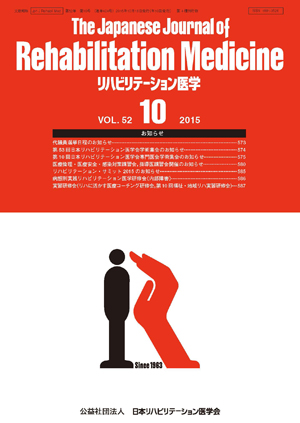巻号一覧

52 巻, 10 号
選択された号の論文の6件中1~6を表示しています
- |<
- <
- 1
- >
- >|
第51回日本リハビリテーション医学会学術集会 パネルディスカッション
-
2015 年 52 巻 10 号 p. 599-604
発行日: 2015年
公開日: 2015/11/10
ジャーナル フリーPDF形式でダウンロード (1607K) -
2015 年 52 巻 10 号 p. 605-614
発行日: 2015年
公開日: 2015/11/10
ジャーナル フリー
脳性麻痺リハビリテーションとニューロリハビリテーション治療のハイブリッド化について…朝貝 芳美 605
自閉症の医学的リハビリテーション…髙橋 脩 609
小児専門病院における発達障害児に対する取り組み…橋本 圭司 611抄録全体を表示PDF形式でダウンロード (1541K)
短報
-
竹川 徹, 持尾 健二郎, 佐藤 友治, 桂田 功一, 深田 実里, 青砥 桃子, 木下 一雄, 安保 雅博2015 年 52 巻 10 号 p. 615-620
発行日: 2015年
公開日: 2015/11/10
ジャーナル フリー目的:長拇趾屈筋(FHL)と長趾屈筋(FDL)の,各足趾への支配の様態について検討することにより,下肢痙縮によるかぎ爪様趾の足趾変形に対するボツリヌス毒素で,より高い治療効果を得る.対象と方法:平均年齢62.3 歳(男性11 名,女性4 名)の15 名の脳卒中後遺症の患者を対象とし,FHLとFDLへの電気刺激時の,足趾の反応性筋収縮の様態について,観察研究として2 名の医師により調査,分析した.併せてご遺体3 体6 肢で,FHLとFDLについて,足関節から足趾への停止部付近を解剖した.結果:FHLの刺激では,観察できた全例で第1 趾の,92.3 %で第2 趾の筋収縮を認めた.FDLの刺激では,観察できた64.3 %に第2趾の筋収縮を欠いた.解剖では,FHL腱は,6 肢全例でFDL腱へ分枝,合流していた.結論:下肢痙縮患者のかぎ爪様趾の足趾変形に対して,FHL,FDLへボツリヌス毒素を施注する際,特に第2 趾を標的とした場合には,FDLのみならず,FHL等への施注も検討されるべきである.抄録全体を表示PDF形式でダウンロード (654K)
症例報告
-
浜田 智哉, 今井 千尋, 山下 愛茜2015 年 52 巻 10 号 p. 621-624
発行日: 2015年
公開日: 2015/11/10
ジャーナル フリーWe reported our experiences with providing speech-language therapy to foreign language-speaking patients. The patients were English, Spanish, Chinese, Swahili and Persian speakers. The primary therapist was Japanese and had no experience in many of the target languages. Assessments were made and treatments were delivered to the patients with the assistance of interpreters and necessary information obtained from the Internet. Of the five patients reported, 3 patients were assessed as unimpaired or suffering only very mild aphasia and received no therapy, and 2 patients were assessed with severe aphasia and received speech-language therapy. It was indicated that the presence of an interpreter, the severity of aphasia and the accessibility to target language speech-language therapy information were the important factors in conducting foreign language therapy. In addition, arrangements need to be made to include a means to correct a patient's utterances, provide immediate feedback during therapy and translate all of the testing materials.抄録全体を表示PDF形式でダウンロード (269K)
総説
-
青柳 陽一郎, 佐伯 覚, 沢田 光思郎, 松嶋 康之, 土岐 めぐみ, 和田 恵美子, 木下 篤, 川手 信行, 小林 宏高, 近藤 和泉 ...2015 年 52 巻 10 号 p. 625-633
発行日: 2015年
公開日: 2015/11/10
ジャーナル フリーPost-polio syndrome (PPS) is the term used to describe the symptoms that may develop many years after acute paralytic poliomyelitis( APP). In the case of PPS, the symptoms and signs include progressive muscle wasting and weakness, limb pain, and/or fatigue, occurring one or more decades after maximal recovery from APP. An overuse of enlarged motor units is suspected to cause the deterioration of some nerve terminals or the loss of the motor units themselves. This could in turn induce PPS symptoms such as new muscle weakness and atrophy. Electromyography (EMG) is often a strong tool to diagnose and evaluate PPS. Some studies have shown that mild to moderate intensity muscular strengthening has a positive effect in patients affected by PPS. Rehabilitation for PPS patients should utilize a multiprofessional and multidisciplinary approach. PPS patients should be advised to avoid both inactivity and overuse of the affected muscles. Finally, patient evaluation is often required to access the need of orthoses and assistive devices.抄録全体を表示PDF形式でダウンロード (1237K)
地方会
-
2015 年 52 巻 10 号 p. 634-641
発行日: 2015年
公開日: 2015/11/10
ジャーナル フリーPDF形式でダウンロード (663K)
- |<
- <
- 1
- >
- >|